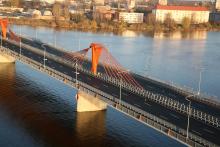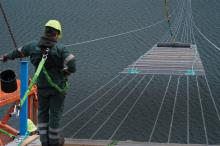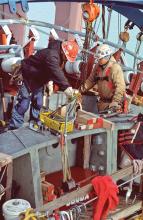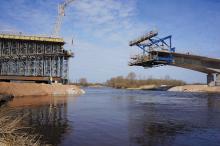An alliance of companies has come together to realise major infrastructure projects in Latvia including its biggest bridge. Patrick Smith reports. Riga, the Latvian capital, has the finest collection of Art Nouveau buildings in Europe and its centre is on the UNESCO World Heritage List.
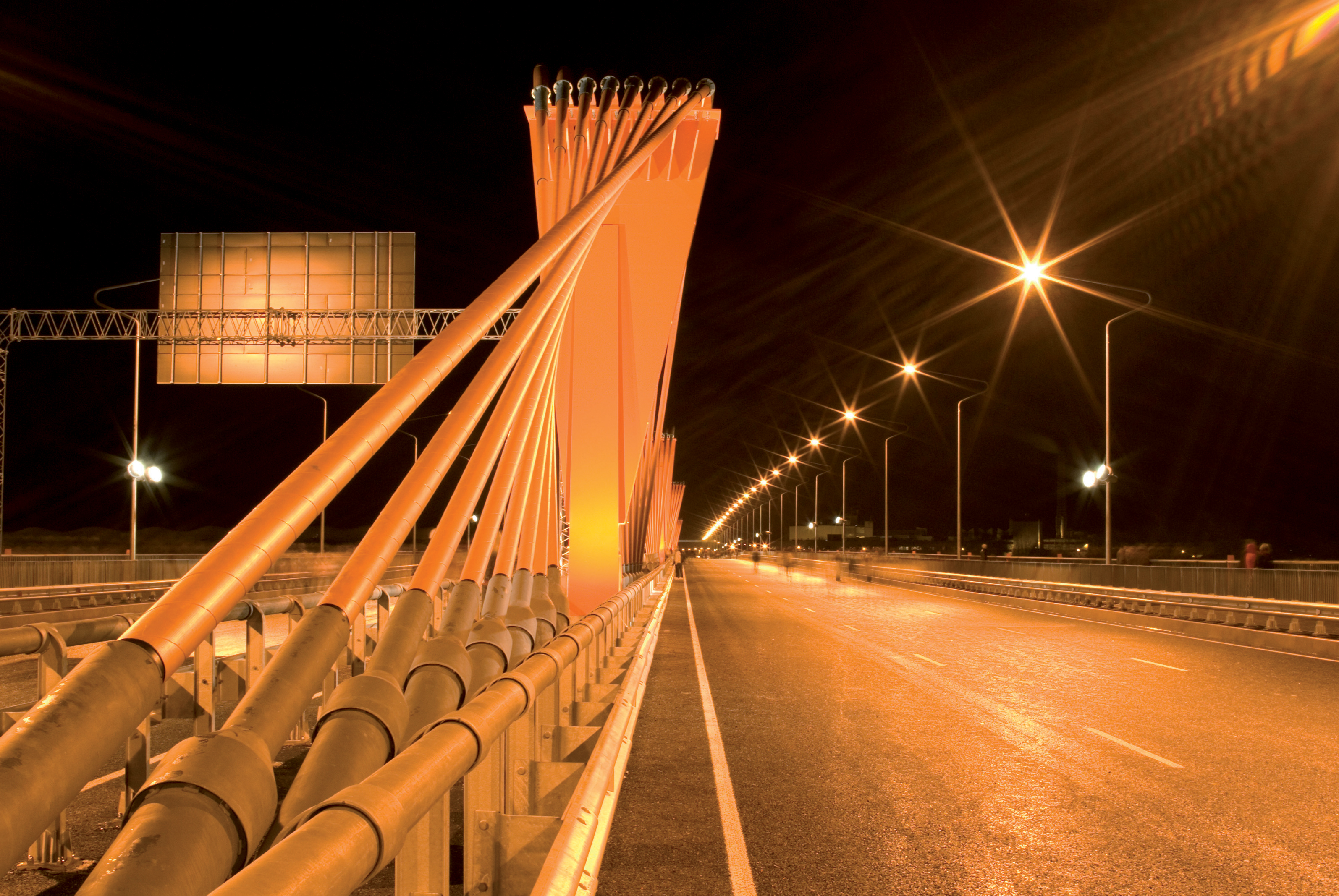
The impressive bridge at night showing the cables arranged in a fan shape
An alliance of companies has come together to realise major infrastructure projects in Latvia including its biggest bridge. Patrick Smith reports
Riga, the Latvian capital, has the finest collection of Art Nouveau buildings in Europe and its centre is on theThe city of some 750,000 people (the country's total population is 2.2 million) is bounded to the south by Lithuania and to the north by Estonia, and is the second largest in Baltic States. To the east is Russia and Belarus.
Despite its rich heritage of over 800 richly decorated and impressive Art Nouveau buildings, until recently the city had only four bridges spanning the River Daugava, the main waterway running through the country into the Gulf of Riga and the Baltic Sea. The railway bridge is the oldest existing bridge across the Daugava and was originally opened in 1914. In 1957 construction of the Stone Bridge was completed. The Island Bridge was built from 1975-1977 and the last bridge built in Riga was the Guyed Bridge, which since 1981 has connected K.Valdemara Street and Kalnciema Street. The new Southern Bridge across the river has been built after an almost 30-year break although the construction of a bridge on the site was marked on the Riga City development plans in 1937.
The river is frozen in January as temperatures drop to -25°C and lower, and the large passenger boats have to smash their way through the ice to the Baltic.
Increased trade with neighbouring countries, along with increasing local traffic, means more transit vehicles passing through Riga, and this has put tremendous pressure on the highway system causing regular traffic jams.
The need for another river crossing to the south of the city, an increasingly popular tourist destination, became inevitable and a huge, complex three-tier interchange system (the first in Latvia and the Baltic countries) to replace a hopelessly outdated roundabout is also under construction to link into the bridge. The top deck will carry heavy transit vehicles only thus keeping other routes clear for local traffic. There is even talk of yet a further crossing to the north of the city although that is some years away yet (see panel Riga Northern Transport Corridor).
Work on the projects are being carried out by Transport Systems, an alliance of companies combining six of the most experienced representatives of the construction sector in Latvia (
The alliance's stated mission is "to breathe new life into regions and cities and give them the opportunity for steady development in the future." Indeed, only recently as part of this commitment Transport Systems has become the new patron of the
Transport Systems' chairman Guntis R?vis said: "History shows that Latvians have the potential to take on world-class Herculean tasks. Our ballet dancers have long been famous outside Latvia. Transport Systems also hopes to carry Latvia's name into Europe and the rest of the world. The purpose of our work, construction, is to help cities around the globe to renew them to ensure that they can function successfully. But it is artists and culture which enliven cities. With this donation we want Latvia to continue to have a ballet troupe and top class dancers to be proud of."
Meanwhile, his company is helping to upgrade some of Latvia's main highways, which total an estimated 70,000km of paved roads.
Latvian State Roads is a 100% state-owned joint stock company and its shares are managed by the Ministry of Transport of the Republic of Latvia.
The most important transport corridor, crossing Latvia in a north-south direction, is the Via Baltica, the European transport corridor also known as the E67 motorway, linking the cities of Helsinki (Finland), Tallinn (Estonia), Riga, Kaunas (Lithuania), Warsaw (Poland) and the E77 (Riga, Kaliningrad in Russia and Gdansk in Poland). The Southern Bridge is part of this. Another major transport corridor that crosses Latvia west to east is the E22, which starts in Britain and runs to central Russia.
The new Southern Bridge over the Daugava had been a necessity for years as the eastern boroughs grew rapidly and traffic increased. The scale of work required included the bridge over the river itself and interchanges with scaffoldings at the junctions with Masavakas and Krasta Streets (two major thoroughfares) at points of entry and exit. The bridge is the most complex and largest construction project undertaken in the Baltic States in the last 25 years, and work on its access roads are expected to last until 2011.
Main contractor for the bridge works was
The Institute Giprostroymost of St Petersburg, Russia, won the tender contest and designed the Southern Bridge by order of the Construction Authority of the Riga Municipal Council with the City Development Department of the Riga Municipal Council acting as the employer and SIA Tiltprojekts acting as the general planner.
The 803m long bridge (49.5m + 77m + 5x110m + 77m + 49.5) is 34.28m wide and carries six lanes of traffic (three in each direction) as well as a pedestrian path and a cycle lane on both sides.
Six pylons, each 13.33m above the road, are installed with bright orange-coloured cables to support the spans.
The engineering geological conditions mean that the bridge supports (there are ten piers in total) are designed on bored piles within sheath steel pipes 1.42m in diameter, based on dolomites and high grillage. The supports are constructed in land cofferdams with underwater concrete layer deposited after laying the pile foundation and subsequent concrete casting of the grillage and support bodies.
The superstructure has been designed in the form of continuous stiffening girder with pre-stressed reinforced concrete plate and pillar complex situated under supports 2, 3, 4, 5, 6, 7 and cable stays, creating precedent tension of the reinforced concrete plate (the so-called extradosed approach that has become popular worldwide in recent years).
The bridge superstructures of the extradosed approach are intermediate between the conventional girder method stiffened by the girder itself and the cable stayed method where stiffness is provided mainly with the cable stayed truss while the girder stiffness is smallish.
During the last 30 years there have been some 100 projects with superstructures of this type, the most prominent in Europe being the Sunniberg Bridge in Switzerland (engineered by Christian Menn).
The main design concept of the Southern Bridge superstructures is about the pre-stressed elements (cable stays) brought outside the girder section in the form of a truss which allows to decrease the bending factor in the girder and transfer the stress to the girder in the tensile areas (above the supports) through pre-tension. The girder bridge cables provide horizontal squeeze reduction of the super support areas, while in the conventional cable stayed bridges, the cable stays provide elastic absorption of vertical loads.
One of the advantages of the extradosed superstructures is that the cable stays are not exposed to fatigue loads as axis stress in cable stays remains mild at changes of temporary loads in superstructures.
The bridge towers are reinforced steel-concrete structures and the cables are saddle supported by towers with cable anti-kink sets arranged in the upper parts. The cable anti-kink saddle is engineered to block the difference of horizontal forces in the towers when the temporary loads are positioned unsymmetrically to the towers, that is, to prevent slipping of cable strands.
The Southern Bridge saddles were exclusively designed. Each tower is equipped with a set of eight separate saddles (one saddle for each pair of cables). The saddle consists of a metallic tube with complex geometry compliant with architectural requirements (cables arranged in fan pattern and in different planes). The tube is supported by the foundational plate through ribbing. Each saddle bundles 37 individual pipes (strands) fixed with fibre concrete. Each of 37 strands consists of seven galvanized wires and has its own sheath, and all the strands are tightened into a common sheath made from high density polyethylene. The strands are anchored with special cable collets designed and manufactured by French company
An advantage of the monostrand technology applied in the cable stay system is the possibility to replace cables during the usage in a strand-by-strand procedure: that is, without complex additional structures and even without stopping traffic over the bridge.
One of the significant advantages of extradosed bridges against conventional girder bridges is a smaller weight of metal and thus smaller costs. Metal usage rate for the Southern Bridge superstructures was approximately 230kg/m2. Similar girder bridges of reinforced steel-concrete with the same superstructures normally require 300-350kg/m2.
The 'guyed' bridge system also allows the distance between the bridge piers to be considerably increased, thus making the bridge visually much more attractive.
The right or east bank scaffoldings have been designed in order to provide two and three-level junctions for entry and the scaffolding superstructures comprise single-piece reinforced concrete pre-tensioned curvilinear structures.
The main traverse superstructures comprise ribbed-plated structures, 1.4m high with either two or four ribs in a section. Such a design allowed covering spans up to 32m. Approach and exit superstructures in section are single-ribbed structures 1.2m high covering spans up to 24m.
In architectural respect, the bridge combined with the scaffoldings appears as an ingenious construction project, even unique in many aspects, and harmonious with the existing bridges over the River Daugava and existing buildings, offering additional decoration for the city.
Following its success, Dr Armands G?tmanis, vice president international relations Transport Systems, said the organisation is looking for international markets, first of all to more liberal European markets such as the Netherlands, Norway, the United Kingdom, and possibly Denmark, Belgium and Germany.
"These countries are investing heavily in infrastructure projects, such as roads, ports, viaducts, bridges, and it seems that it would be timely appropriate to offer qualitative engineering and building services. JSC Transport Systems would like fo find local partners in these countries and establish benefitial cooperation with them. Transport Systems is looking toward countries such as Ukraine, Kasachstan, Byelorussia and others as potential markets as well."

